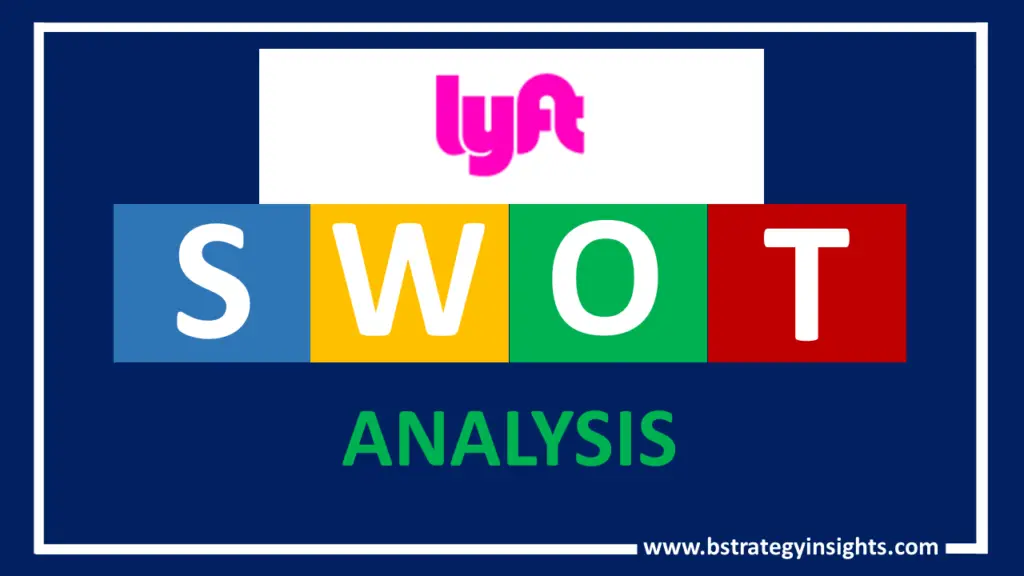
Lyft is a popular American rideshare app and company that has its headquarters in San Francisco, California. The main purpose of the app was to try and connect drivers looking to earn money with riders looking for a ride. It is a leading transportation network operator in Canada and the US. Since its inception in 2012, Lyft has enjoyed unprecedented strong growth in its rider and driver network. With its purchase of the Motivate in 2018, the brand became the largest bike-sharing company in the United States of America.
This was up until 2019, when it reached 22.9 million. Then, unfortunately, the pandemic severely impacted the brand, which led to a sharp decline in the number of active riders and in net revenues for the periods ranging from 2019 to 2020.
This article presents the SWOT analysis of Lyft. A SWOT analysis is a critical strategic tool that seeks to determine a brand’s competitive position in the market. It gives insights into a brand’s strengths, weaknesses, opportunities, and threats so that the brand is able to compete favorably in the market.
Lyft – At a Glance
| Name | Lyft, Inc. |
| Website | lyft.com |
| Founders | Logan Green, John Zimmer |
| Chief Executive Officer (C.E.O.) | Logan Green, |
| Headquarters | San Francisco, California, U.S |
| Year Founded | June 9, 2012 |
| Revenues (FY 2020) | US$2.364 billion |
| Key Products/Services | vehicles for hire, motorized scooters, a bicycle-sharing system, rental cars, and food delivery |
| Key Competitors | Getaround, Ola Cabs, Didi Chuxing, Grab, Ridecell |
Strengths of Lyft
A large network of both riders and drivers
the brand boasts of a huge transportation network in the US and in Canada. Through new acquisitions and partnerships, the brand has been able to continuously strengthen its network. The recent acquisition of Motivate had the company become the largest bike-sharing service provider in the US.
To enhance its network in the region of drivers, the brand has car rental services so that drivers who do not have cars that match Lyft’s car requirements can easily rent a car and earn an income. The brand has also partnered with Aptiv and Waymo so that its riders can have access to vehicles.
Diversification of products and services
Lyft has diversified its services; for each of the customer segments, the brand has customized transportation solutions. Each of these customer segments is presented with attractive subscription packages for individual customers.
Examples of these programs include Lyft Pink, which allows riders to manage their riding costs more effectively and derive more value from their membership. In addition to serving individual customers, the brand also offers transportation solutions tailored for small and large enterprises for industries like healthcare, education, and government sectors. The brand also works in partnership with travel and expense management companies like Certify and Expensify and SAP Concur for a seamless traveling experience.
Strong growth
Lyft as a brand has in the recent past experienced stronger growth. The largest players in the US rider industry are Uber and Lyft. As of 2017, Uber had a 74% market share, which declined to 68% by 2021; Lyft’s market share on the other rose to 32%. The brand has also experienced growth in its rider network. Its rider network grew to 22.9 million riders compared to a similar period increase to 18.6 million.
Some of the factors that drove up the growth rate of Lyft include an increased focus on technological innovation, exclusive membership benefits, higher engagement rates, and increased focus on marketing, among others. Except for the effects of COVID 19, Lyft’s growth would be much more than what it has attained today. Even then, the brand has shown stronger signs of growth; the quarter ending 31st March registered 21.2 million active riders when compared to 20.5 riders in a similar period in the previous year.
Strong technological innovation
The brand has strongly invested in innovation, which has been a great differentiator for the brand in the market, enabling the brand to deliver a superior customer experience across its product segments. This is reflected in the amounts of funds spent on research and development.
In 2016, the brand spent 64.7 million USD on research and development; by 2019, the brand spent more than $1.5 billion in research and technology. The brand uses technological innovation to edge out the huge competition in the rider market and increase its market share. The brand also partners with other brands for better research and development initiatives.
Strong brand awareness
Lyft is now a household name in the markets where it has its presence. This has been achieved through a consistent focus on customer service and marketing.
Largest bike-sharing company in the US
After its acquisition of Motivate, Lyft became the largest bike-sharing brand in the US. This service was offered in cities that have the densest populations.
Weaknesses of Lyft
Continued losses
Despite the improved performance of the brand in the marketplace, and despite the outstanding growth rates, the brand has still suffered losses. Lyft recorded an increase of $1.5 billion in gross revenues but registered a $1.7 billion loss in the same period. In 2019 and 2018, the brand recorded a $2.6 billion and $911 million loss, respectively.
During 2019, the brands losses decreased significantly even as revenues decreased due to the pandemic. These continued losses pose a challenge with regards to the brand’s ability in meeting it is short term as well as long term obligations. This could injure the brand’s relationship with its creditors and therefore threaten its operations.
Limited to US and Canadian markets
Unlike Uber that expanded its markets to the globe, Lyft only has its operations in Canada and the US. This poses a significant threat to the firm’s existence in the event of an adverse event impacting its key markets.
Lyft’s limited choice of markets to operate limits its revenue expansion; the brand will therefore continue to make losses, which it would have overcome if it had broadened its market reach.
Opportunities of Lyft
Global expansion
Lyft has the opportunity to expand outside its US and Canada primary markets. This global expansion will help the brand grow its revenues and increase its profits. Lyft must consider expanding into such markets like the UK, Asia, and India, among others; these among other emerging markets provide Lyft with great opportunities for growth.
Acquisitions and diversification
Lyft has the opportunity to grow through diversification and acquisitions. The brand could acquire and diversify into areas of strategic interest to the brand to broaden its service offering and as well sharpen its competitive edge in the market.
Threats of Lyft
Stiff competition
Lyft as a brand faces fierce competition from other companies in the market. This heightened competition is a leading factor that has challenged the brand’s ability to grow at a faster rate. Competition limits the brand’s ability to expand and grow.
Regulatory threats
Initially, the rider market was not as regulated as it is now. With the rise of Uber, the government became more aware of the rising industry and started instituting laws to regulate this space. This regulatory framework has made it more challenging and complex for players to operate in some areas.
Conclusion
Lyft is a huge brand with strong growth in recent years. And although there is stiff competition in the market, Lyft has a great potential to grow with this momentum and achieve more market share, revenues, and profitability in the marketplace.


